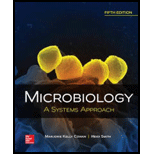
Microbiology: A Systems Approach
5th Edition
ISBN: 9781259706615
Author: Marjorie Kelly Cowan Professor
Publisher: McGraw-Hill Education
expand_more
expand_more
format_list_bulleted
Question
Chapter 12, Problem 11TF
Summary Introduction
To identify:
The categories of drugs that are most selectively toxic and also give the reasons.
Concept introduction:
Antimicrobial agents differ in their mode of action, including inhibition of cell wall, inhibition of protein and
Expert Solution & Answer
Trending nowThis is a popular solution!

Students have asked these similar questions
The Sentinel Cell: Nature’s Answer to Cancer?
Molecular Biology Question
You are working to characterize a novel protein in mice. Analysis shows that high levels of the primary transcript that codes for this protein are found in tissue from the brain, muscle, liver, and pancreas. However, an antibody that recognizes the C-terminal portion of the protein indicates that the protein is present in brain, muscle, and liver, but not in the pancreas. What is the most likely explanation for this result?
Molecular Biology
Explain/discuss how “slow stop” and “quick/fast stop” mutants wereused to identify different protein involved in DNA replication in E. coli.
Chapter 12 Solutions
Microbiology: A Systems Approach
Ch. 12.1 - State the main goal of antimicrobial treatment.Ch. 12.1 - Identify sources of the most commonly used...Ch. 12.1 - Summarize two methods for testing antimicrobial...Ch. 12.1 - Prob. 4AYPCh. 12.2 - Prob. 5AYPCh. 12.2 - Describe the five major targets of antimicrobial...Ch. 12.2 - Identify which categories of drugs are most...Ch. 12.3 - Prob. 8AYPCh. 12.3 - Trace the development of penicillin...Ch. 12.3 - Prob. 10AYP
Ch. 12.3 - Prob. 11AYPCh. 12.3 - Prob. 12AYPCh. 12.3 - Prob. 13AYPCh. 12.3 - Identify the cellular target of quinolones, and...Ch. 12.3 - Prob. 15AYPCh. 12.3 - Prob. 16AYPCh. 12.3 - Prob. 17AYPCh. 12.3 - Prob. 18AYPCh. 12.3 - Describe two major modes of action of antiviral...Ch. 12.4 - Prob. 20AYPCh. 12.4 - Prob. 21AYPCh. 12.4 - Discuss at least three novel antimicrobial...Ch. 12.5 - Distinguish between drug toxicity and allergic...Ch. 12.5 - Prob. 24AYPCh. 12 - Prob. 1MCQCh. 12 - Prob. 2MCQCh. 12 - Prob. 3MCQCh. 12 - Microbial resistance to drugs is acquired through...Ch. 12 - Prob. 5MCQCh. 12 - Prob. 6MCQCh. 12 - Prob. 7MCQCh. 12 - Which of the following modes of action would be...Ch. 12 - Prob. 9MCQCh. 12 - Prob. 10MCQCh. 12 - Prob. 11TFCh. 12 - Prob. 12TFCh. 12 - Biofilms are difficult to treat and do not always...Ch. 12 - Prob. 14TFCh. 12 - Prob. 15TFCh. 12 - Construct a paragraph describing the...Ch. 12 - Prob. 2CTQCh. 12 - Antibiotic-resistance genes, as well as other...Ch. 12 - Prob. 4CTQCh. 12 - What is the significance of the bottom row in...Ch. 12 - Figure 12.5. Where could penicillinase affect each...Ch. 12 - From chapter 6, process figure 6.14a. Describe as...Ch. 12 - Prob. 1CM
Knowledge Booster
Similar questions
- Molecular Biology Question A gene that codes for a protein was removed from a eukaryotic cell and inserted into a prokaryotic cell. Although the gene was successfully transcribed and translated, it produced a different protein than it produced in the eukaryotic cell. What is the most likely explanation?arrow_forwardMolecular Biology LIST three characteristics of origins of replicationarrow_forwardMolecular Biology Question Please help. Thank you For E coli DNA polymerase III, give the structure and function of the b-clamp sub-complex. Describe how the structure of this sub-complex is important for it’s function.arrow_forward
- Molecular Biology LIST three characteristics of DNA Polymerasesarrow_forwardMolecular Biology RNA polymerase core enzyme structure contains what subunits? To form holo enzyme, sigma factor is added to core. What is the name of the structure formed? Give the detailed structure of sigma factor and the function of eachdomain. Please help. Thank youarrow_forwardMolecular Biology You have a single bacterial cell whose DNA is labelled with radioactiveC14. After 5 rounds of cell division, how may cells will contain radioactive DNA? Please help. Thank youarrow_forward
- 1. Explain the structure and properties of atoms and chemical bonds (especially how they relate to DNA and proteins). Also add some pictures.arrow_forward1. In the Sentinel Cell DNA integrity is preserved through nanoscopic helicase-coordinated repair, while lipids in the membrane are fortified to resist environmental mutagens. also provide pictures for this question.arrow_forwardExplain the structure and properties of atoms and chemical bonds (especially how they relate to DNA and proteins). Also add some pictures.arrow_forward
- In the Sentinel Cell DNA integrity is preserved through nanoscopic helicase-coordinated repair, while lipids in the membrane are fortified to resist environmental mutagens. also provide pictures for this question.arrow_forward1. Explain how genetic information is stored, copied, transferred, and expressed. Also add some pictures for this question.arrow_forward!. Describe biological macromolecules (DNA, RNA, proteins, lipids, etc.) and how they function in the cell. also provide some images for this question.arrow_forward
arrow_back_ios
SEE MORE QUESTIONS
arrow_forward_ios
Recommended textbooks for you
- Basic Clinical Lab Competencies for Respiratory C...NursingISBN:9781285244662Author:WhitePublisher:CengageEssentials of Pharmacology for Health ProfessionsNursingISBN:9781305441620Author:WOODROWPublisher:Cengage
 Comprehensive Medical Assisting: Administrative a...NursingISBN:9781305964792Author:Wilburta Q. Lindh, Carol D. Tamparo, Barbara M. Dahl, Julie Morris, Cindy CorreaPublisher:Cengage Learning
Comprehensive Medical Assisting: Administrative a...NursingISBN:9781305964792Author:Wilburta Q. Lindh, Carol D. Tamparo, Barbara M. Dahl, Julie Morris, Cindy CorreaPublisher:Cengage Learning

Basic Clinical Lab Competencies for Respiratory C...
Nursing
ISBN:9781285244662
Author:White
Publisher:Cengage

Essentials of Pharmacology for Health Professions
Nursing
ISBN:9781305441620
Author:WOODROW
Publisher:Cengage



Comprehensive Medical Assisting: Administrative a...
Nursing
ISBN:9781305964792
Author:Wilburta Q. Lindh, Carol D. Tamparo, Barbara M. Dahl, Julie Morris, Cindy Correa
Publisher:Cengage Learning
